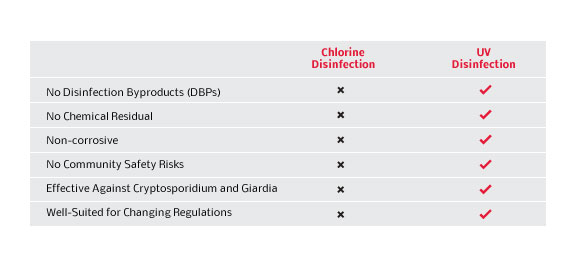An Independent Study by Bronte Stahl, student at Marcellus Senior High School
Marcellus Sewage Treatment Plant Upgrade
How the Village of Marcellus took on a 7.7 million dollar project to better the safety of the community and environment.
Marcellus Sewage Treatment Plant Upgrade
How the Village of Marcellus took on a 7.7 million dollar project to better the safety of the community and environment.

With pressure from the Onondaga Lake Cleanup and new DEC limits on the element phosphorus, a team of plant operators, engineers and contractors began the project to upgrade the Marcellus Sewage Treatment plant in early 2018. The upgrade includes a new ultraviolet disinfection system and a chemical feed system that removes phosphorus, required by the DEC.
The Marcellus Sewage Treatment Plant used chlorine disinfection until the early months of 2020. The chlorine disinfection method is effective for killing germs and eliminating odor in water, but it has many disadvantages.
Phosphorus is a naturally occurring nutrient needed for plant and animal growth. If the amount of phosphorus becomes eutrophic, it can have adverse effects on the surrounding environment. Increased levels can cause accelerated plant growth, algae blooms, low dissolved oxygen and the death of certain fish, invertebrates and other aquatic animals.
Chlorine v. Ultraviolet (UV) Disinfection
The chlorine disinfection system included chlorine gas that was added to the effluent in a tank. Sulfur dioxide was then added to remove the chlorine before the effluent entered Nine Mile Creek. The daily limit was 0.1 mg/L residual of chlorine, set by the permit from the State Pollutant Discharge Elimination System (SPDES).
There are four trihalomethanes (THMs) that are most commonly found in chlorinated water. Chloroform and bromodichloromethane has been identified by the U.S. Environmental Protection Agency (EPA) as Group B2, or probable human carcinogen. Dibromochloromethane and bromoform are in Group 3, or possible human carcinogen2. To find more about these by-products, click here. Although the plant was vigilant about removing the chlorine from the water, it could still be found in the pipes or tanks in small amounts.
The UV disinfection system is the last treatment the water goes through before flowing into Nine Mile Creek. The water passes through a channel where UV lamps shine into it, which neutralizes the microorganisms and leaves the water’s chemical composition untouched. The microorganisms the UV light inactivates includes protozoans like Giardia lamblia cysts, Cryptosporidium oocysts and fecal coliform. By eliminating these, harmful pathogenic organisms are prevented from entering Nine Mile Creek.
Giardia cause infection by attaching to the wall of the small intestine in the upper gastrointestinal tract of humans and other vertebrates3. Cryptosporidium causes watery diarrhea, the parasite is found in every region of the United States4. Fecal coliform is not naturally occurring in the environment, since it only inhibits the intestines of warm-blooded animals and their waste5. If fecal coliform is present, it is likely that pathogenic organisms and E. coli are also present. The plant is required to test for fecal coliform monthly, and the UV system continually inactivates it from the effluent.
Poly Aluminum Chloride (PAC)
Poly Aluminum Chloride is used to remove phosphorus from the effluent going into Nine Mile Creek. Although there are many sources of phosphorus, such as runoff and bank erosion, the plant is making sure they contribute as little phosphorus as possible. The plant is still testing various types of PAC to determine which form and mixture is most effective here at the Marcellus Sewage Treatment Plant.
Poly Aluminum Chloride is a clear, yellow, sticky liquid, thicker than water. It is mixed into the sewage in the aeration tanks, just as it transfers into the secondary clarifiers. As it mixes, phosphorus attaches to the poly aluminum chloride. As the mixture flows in a circular motion, it settles into two separate liquids based on density. The top is clear water and the bottom is sludge. The PAC settles with the sludge, taking the phosphorus with it, leaving the clear effluent to flow through the UV system.
The attached video shares a diagram of the processes and further explanations.
How are samples taken?
What is an aeration tank and secondary clarifier?
How does this effect me?
These questions are all answered if you click the big red box!
Please consider watching!
LEARN MORE (VIDEO)
Huge thank you to all of the professionals who were willing to help and guide me!
Ms. Mallory Reedy, Mr. John Holmes, Dr. McCaffrey, Mr. Tyler Cooper, Mr. Mayor Curtin, Ms. Charnley Abbott
What is an aeration tank and secondary clarifier?
How does this effect me?
These questions are all answered if you click the big red box!
Please consider watching!
LEARN MORE (VIDEO)
Huge thank you to all of the professionals who were willing to help and guide me!
Ms. Mallory Reedy, Mr. John Holmes, Dr. McCaffrey, Mr. Tyler Cooper, Mr. Mayor Curtin, Ms. Charnley Abbott
References
5. “Community and Environment.” Washington State Department of Health, www.doh.wa.gov/CommunityandEnvironment/DrinkingWater/Contaminants/Coliform. “Community and Environment.” Washington State Department of Health, www.doh.wa.gov/CommunityandEnvironment/DrinkingWater/Contaminants/Coliform.
“Department of Health.” Coliform Bacteria in Drinking Water Supplies, www.health.ny.gov/environmental/water/drinking/coliform_bacteria.htm.
Oram, Brian. “Mr. Brian Oram, PG.” Water Research Center - UV Disinfection, www.water-research.net/index.php/water-treatment/water-disinfection/uv-disinfection#:~:text=As%20a%20water%20treatment%20technique,lamblia%20cysts%20or%20Cryptosporidium%20oocysts.
“Trihalomethanes: Health Information Summary .” New Hampshire Department of Environmental Services, 2006, www.des.nh.gov/organization/commissioner/pip/factsheets/ard/documents/ard-ehp-13.pdf.
- “Indicators: Phosphorus.” EPA, Environmental Protection Agency, 7 July 2017, www.epa.gov/national-aquatic-resource-surveys/indicators-phosphorus.
- “Disinfection By-Products.” Centers for Disease Control and Prevention, Centers for Disease Control and Prevention, 2 Dec. 2016, www.cdc.gov/safewater/chlorination-byproducts.html#:~:text=In%20disinfection%2C%20gaseous%20chlorine%20(Cl,and%20have%20similar%20chemical%20characteristics.
- “Giardia: Drinking Water Health Advisory.” United Sates Environmental Agency, www.epa.gov/sites/production/files/2015-10/documents/giardia-report.pdf
5. “Community and Environment.” Washington State Department of Health, www.doh.wa.gov/CommunityandEnvironment/DrinkingWater/Contaminants/Coliform. “Community and Environment.” Washington State Department of Health, www.doh.wa.gov/CommunityandEnvironment/DrinkingWater/Contaminants/Coliform.
“Department of Health.” Coliform Bacteria in Drinking Water Supplies, www.health.ny.gov/environmental/water/drinking/coliform_bacteria.htm.
Oram, Brian. “Mr. Brian Oram, PG.” Water Research Center - UV Disinfection, www.water-research.net/index.php/water-treatment/water-disinfection/uv-disinfection#:~:text=As%20a%20water%20treatment%20technique,lamblia%20cysts%20or%20Cryptosporidium%20oocysts.
“Trihalomethanes: Health Information Summary .” New Hampshire Department of Environmental Services, 2006, www.des.nh.gov/organization/commissioner/pip/factsheets/ard/documents/ard-ehp-13.pdf.